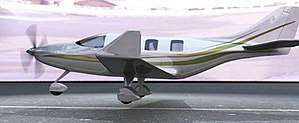Australian Lightwing SP-6000
The Australian Lightwing SP-6000 (or SP6000) was an Australian kit aircraft under development by Australian Lightwing of Ballina, New South Wales. The aircraft was intended to be supplied as a kit for amateur construction.[1][2][3]
| SP-6000 | |
|---|---|
 | |
| Australian Lightwing SP-6000 artist's concept | |
| Role | Kit aircraft |
| National origin | Australia |
| Manufacturer | Australian Lightwing |
| Status | Development ended |
By 2017 the project's webpage had been removed and it was no longer listed on the company website. It is likely that development has ended.[4]
Design and development
The aircraft was designed to comply with the Australian rules for amateur-built aircraft. It featured a cantilever low-wing or optionally strut-braced high-wing, a six-seat enclosed cabin, fixed tricycle landing gear and a single engine in tractor configuration.[1][2][3]
The SP-6000's fuselage was intended to be made from fibreglass with the wing constructed of 6061-T6 aluminium, with S-glass control surfaces. It was to be powered by a Corvette LS3 automotive engine conversion, a 180 to 200 hp (134 to 149 kW) Lycoming IO-360 four-stroke aircraft engine or a turboprop powerplant. The cabin was planned include an optional toilet and galley.[1][3]
The initial design was be unpressurized, but the company was considering a follow-on pressurized version. The high wing version was to have a cruise speed of 145 kn (269 km/h), while the low-wing version would have cruised at an estimated 250 kn (463 km/h).[3]
Specifications (SP-6000 Low wing)
Data from Company[3]
General characteristics
- Crew: one
- Capacity: five passengers
- Empty weight: 750 kg (1,653 lb)
- Powerplant: 1 × Lycoming IO-360 four cylinder, air-cooled, four stroke aircraft engine, 150 kW (200 hp)
Performance
- Cruise speed: 460 km/h (290 mph, 250 kn)
- Range: 1,900 km (1,200 mi, 1,000 nmi)
Avionics
- Glass cockpit
- Trutrac autopilot
References
- Bayerl, Robby; Martin Berkemeier; et al: World Directory of Leisure Aviation 2011-12, page 29. WDLA UK, Lancaster UK, 2011. ISSN 1368-485X
- Tacke, Willi; Marino Boric; et al: World Directory of Light Aviation 2015-16, page 31. Flying Pages Europe SARL, 2015. ISSN 1368-485X
- Australian LightWing (2011). "The SP6000 Australian LightWing - 6 Seat". Archived from the original on 11 February 2016. Retrieved 8 May 2012.
- Australian Lightwing (2017). "Kit Aircraft Range". lightwing.com.au. Archived from the original on 23 June 2020. Retrieved 23 June 2020.